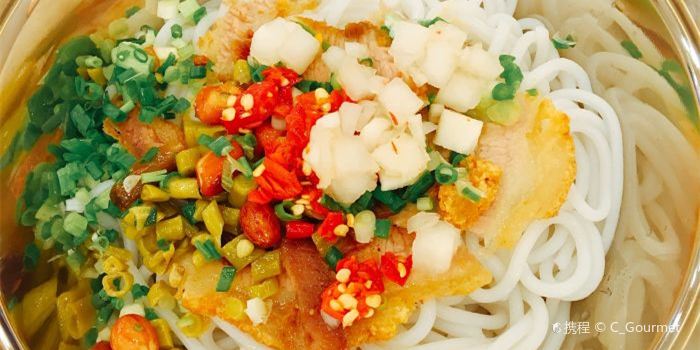Chong Shan MiFen (Yi Ren Road)
4.4/5571 Reviews
Downtown/Elephant Trunk Hill/Two Rivers And Four LakesSAR8

0773-2826036
What travelers say:

Jiangxi rice noodles are a famous traditional snack ingredient in Jiangxi Province. Made from water and rice, and then dried in the sun, they are a Jiangnan delicacy that is rich in starch, minerals, and various vitamins needed by the human body. They are chewy, refreshing, and spicy. They are mainly popular in Jiangxi, Hunan, Guangxi, and other places.
More
Reviews of Chong Shan MiFen (Yi Ren Road)
Some reviews may have been translated by Google Translate
4.4/5Excellent
All (571)
Latest
Photo reviews (61)
Positive reviews (59)
Negative reviews (4)
Jiangxi rice noodles are a famous traditional snack ingredient in Jiangxi Province. Made from water and rice, and then dried in the sun, they are a Jiangnan delicacy that is rich in starch, minerals, and various vitamins needed by the human body. They are chewy, refreshing, and spicy. They are mainly popular in Jiangxi, Hunan, Guangxi, and other places.
Beef rice noodle is a Chinese delicacy. The main ingredients are beef, pickled lotus root, pickled radish, etc. It is popular all over the country for its tender meat, smooth and chewy noodles, clear and strong soup, and spicy and fresh aroma. This is a delicacy that is available in all parts of Fuzhou and is well-known to everyone. Most of the restaurants in Fuzhou are branded as Nanfeng beef rice noodles. In fact, it is a kind of rice noodles with beef as sauce, but because of its unique flavor, it is loved by people. In addition to tasting, drinking a bowl of tempting aroma and strong flavor...
Rice noodles are a special snack in southern China. People in Jiangyou usually call them noodles. Rice noodles are made from rice and are made into strips or threads through soaking, steaming and pressing. They are not powdery materials made from rice as the raw material. Rice noodles are flexible and elastic. They do not become mushy when boiled in water and are not easy to break when stir-fried. They are smooth and tasty when boiled or stir-fried with various vegetables or soup ingredients. They are deeply loved by consumers (especially those in the south). There are many varieties of rice noodles, which can be divided into row rice noodles, square rice noodles, corrugated rice noodles, silver rice noodles, wet rice noodles and dry rice noodles. The production process of rice noodles is similar, generally: rice - washing - soaking - grinding - steaming - pressing (squeezing) - re-steaming - cooling - drying - packaging - finished product.
A very old rice noodle shop, the environment is relatively simple, the emphasis is on cheapness, six yuan a portion of rice noodles is basically enough to fill you up. This is on the pedestrian street, I think it tastes better than the rice noodles in Yangshuo. You can add side dishes yourself, my favorite is sour beans, which go well with rice and relieve greasiness. The service is self-service and it's so cheap, there's nothing to complain about
Chongshan is a chain of rice noodle shops in Guilin. It can be said that the branches are all over the streets and alleys. The one we went to is located in an alley on Zhengyang Street. There were many people queuing up when we walked in. The texture of Chongshan rice noodles is moderate and the taste is good. The bean curd, braised egg, sour beans and other ingredients are also good.
Chongshan Rice Noodles is the earliest chain store in Guilin. Its rice noodles have always been loved by people in Guilin and outsiders. The brine of its stewed rice noodles is a major feature of its store, which makes the taste of this bowl of rice noodles widely praised. Now the store offers a variety of local snacks in Guilin. It is not only about eating rice noodles, but also about the local food culture of Guilin.
There are many rice noodle shops in Guilin. Chongshan Rice Noodles is a well-known rice noodle chain in Guilin. There are several in Guilin. The main store I went to is located near the central square, and it is only a 5-minute walk from the hotel. In addition to tourists, there are more local residents, and many students also come to eat rice noodles. In addition to rice noodles, they also have many rice topped with toppings. We ordered the signature beef brisket rice noodles and stewed rice noodles set meal, which comes with vegetables, fruits, and drinks, and the content is quite rich. The taste of rice noodles is quite satisfactory. It is the first time to eat stewed dishes, and the taste is not bad, especially the crispy part. When eating rice noodles, you can eat soup noodles and dry noodles. If you want to eat soup noodles, you can add soup by yourself next to the pick-up area, and you can also add some small ingredients. The per capita price of this store is about 20 yuan. As a well-known chain restaurant, the price-performance ratio is OK. The store also sells packaged rice noodles. It is also good to buy them and bring them back to relatives and friends.
Guilin rice noodles originated in the Qin Dynasty, and there are many phenomena in Guilin rice noodle culture to prove it: the most primitive rice noodle press that I saw in the Guilin Rice Noodle Culture and Art Museum has a "clutch" on it that is exactly the image of the Qin Dynasty's agricultural tool "lei"; it is said that in the past, vendors selling "dandan rice noodles" all wore wooden shoes on the street, and the sound of wooden shoes on the stone road was like the vendors calling "rice noodles, rice noodles" in an audio advertisement. And wooden shoes are a kind of Qin Dynasty shoes; the Yao migrant workers who participated in the excavation of Lingqu in Xing'an area at that time recorded it in the habit of oral history of their ethnic group, saying that rice noodles were made by Yao compatriots, which has an intrinsic connection with the historical fact that the cooks of the Qin army made them at that time, and the horse head hot pot that the Yao compatriots cooked horse meat rice noodles at that time is very similar to the shape of the Qin Dynasty Terracotta Warriors and Horses unearthed today! Guilin rice noodles reached their heyday during the Qing Dynasty and the Republic of China.